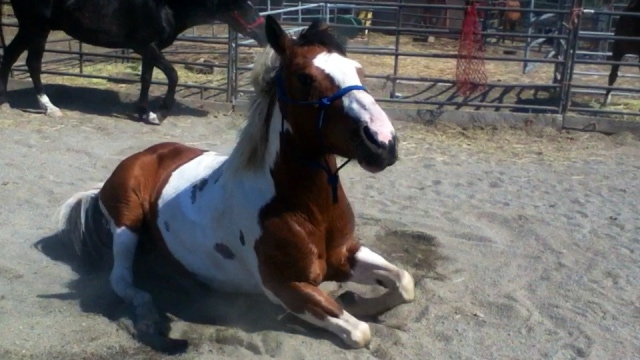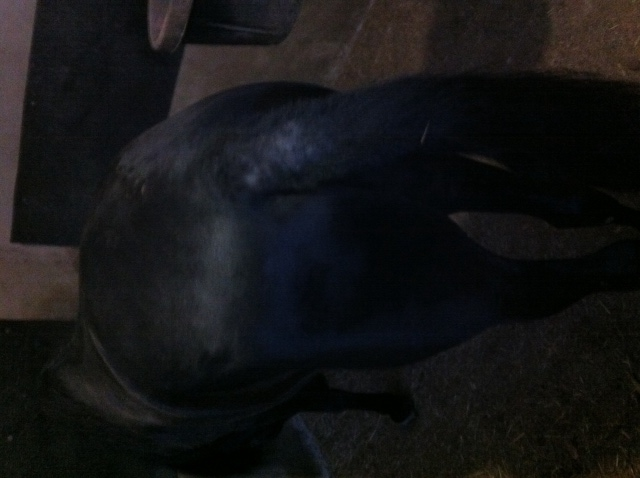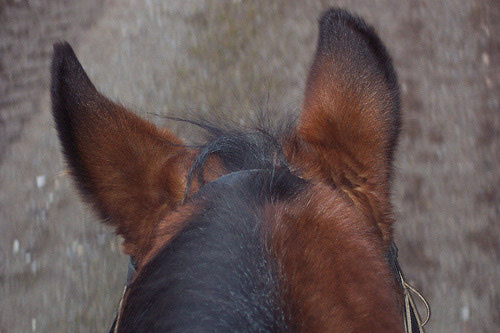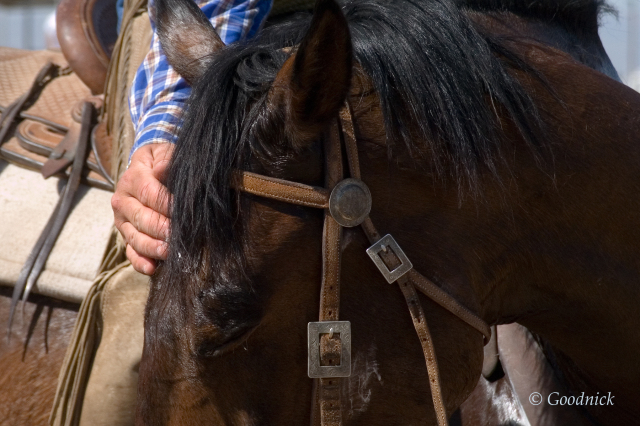QuestionWe just bought a 6 year old gelding that is really gentle but won't take a bit. we tried a split and a straight bit but he slings his head everywhere and dances his feet. Please help we have know idea what to do next. It really tires us out trying to fight with him.
Thank You,
Tina
AnswerResponse from April Reeves, Horseman's U.com
Hello Tina,
The first thing I do when examining a problem is to look for the source. A horse that dances around when you are trying to do anything is doing so out of fear or conditioned response. With fear, the horse will always defend himself (rearing, striking), but your horse sounds as if he is typical of the latter.
The style of bit may or may not matter when you are attempting to bit him. If he tosses his head while riding then it's time to move into a softer bit, preferably a french link with a roller. These bits are similar to snaffles but have one additional break. The middle looks like a small dog bone, and I like to use bits that have a small roller in the middle. The less severe a bit, the more comfortable a horse will be. Harsher bits only create more problems through increased anxiety.
Before you start make sure this is not a tooth problem. Geldings have additional teeth that most mares do not (canines, wolf or 'tushes', used for fighting). Your vet can check for problems. Many horses refuse bitting from pain issues. Once this is ruled out, assume it is a training issue.
These steps you will take next can be quite difficult, and usually require a qualified trainer. I am not going to tell you this is easy as issues around a horse's head can be very difficult to work with.
Step 1
Everything we do with horses is training: everything. Quite often when bitting, owners begin the process, putting the bridle up to the horse and getting the bit near the mouth, but when the horse pulls away the owner stops the process, and the horse was just rewarded for it's effort. Make the right things easy and the wrong things difficult. In this case, your reward has been every time you quit. Let's reprogram the horse first by changing your reward technique. He's not a bad horse. He simply learned to dance because he though this is what you were rewarding him for.
Put a halter and long lead shank on the horse (rope halter is preferable).
Next, instead of trying to bit the horse, we are going to teach him to stand quietly and enjoy the process. Take up the bridle (with no reins attached) and bit but make no attempt to put the bit in his mouth. Instead, carry a small treat in the bit hand. Hold it in a way that the horse will not get at the treat until you release it.
Now, this is the part where patience enters and anger leaves. Hold the crown (top) of the bridle in your right hand. You may either hold your right hand over his head through his ears or under his jaw and over the bridge of his nose, which ever method makes him most comfortable. This right hand will not put any pressure on the horse's head, but just follow the horses movements, always being there with him. It never leaves. The re-programming message is "I will always be there regardless of what you do, but I will never hurt you". Follow him up and down, side to side quietly, being careful not to hit his face with the bit.
By now he is probably starting to dance. Move with him. The trick here is to not move away or lose your soft contact. Have the treat close to his mouth. Make sure the bit does not make contact with his head. He will likely dance around for quite a while. Patience, keep the hands in place and follow him. I use a handler on the halter, but do not put pressure on the horse. Handlers simply keep the horse from moving left or right too far. Do not attempt to hold the horse in place with the halter. The handler's job is to direct the horse with little to no pressure. Allow him to back up. Horses need to feel like they can move their feet. Eventually he will tire from this and slow down and stop. Be patient.
If he continues to move, continue to follow. If you get angry and apply any pressure, the lesson is gone and you will have a tougher time as you have just destroyed trust. With horses, less is more. I have followed horses for over an hour, but they eventually stop. Stopping is a survival technique also, which usually kicks in when the horse realizes you are not going anywhere and there is no pain or pressure attached. Once the horse stops, it is a sign he is ready to think. Surrender is thought.
By now your arm is killing you and you want to sell him. Good! The moment of him stopping is almost there. Once that happens, and he is standing quietly, reward him with the treat, take the bridle away and pat him. The timing for this is the instant he is quiet, not two minutes after.
Then stand away and let him think about what just happened. This is the 'magical' part of training; this is what I teach in every clinic. It is in this small moment of surrender and reward that you gain trust, and although it may feel small to you, it is a very big deal to the horse. Timing is crucial here. He must be quiet before receiving the reward.
Once you have given him 30 seconds of 'think' time, go back to the beginning, keeping the treat in your left hand with the bit and the right hand holding the bridle softly in place. Prepare your arms for another session of pain. Once he stops and softens, treat him again, remove the bridle, stand back and wait 30 seconds. Repeat, repeat and repeat, until this means nothing to him other that "wow, this is great, I get fed". Normally I do not use treats for most of my training, but this is one place where it works very well. Eventually he will stand still and look for the treat. It may feel like you have replaced the dancing problem with a treat problem, but now we have a horse looking to place his muzzle in the hand with the bit.
Step 2
Now it's time to ask him to accept this part. If you have a rubber bit around, it may be useful to use this at first, so he won't feel the metal hitting his teeth.
Position yourself again with both hands. When he is quiet, place a finger inside his gum area, moving it around, getting him use to things in his mouth. Do it only for a short second or two at first. Once you stop, stand back for 30 seconds and let him think again. Then go back and do it again. Make sure to keep your finger close to the gum area, do not put it in this mouth; you may get bit accidentally. Once he accepts that quietly, treat him once at the end of it. As he accepts this, ask a bit more of him, putting a little pressure on his gums to ask him to open his mouth. (You should be in this for about one hour at this point. I'm letting you know so that you prepare the necessary time up front.)
At this point I usually put the horse away. The next day I do it again, from the start, and if it's done correctly, the horse usually settles in quickly. I will move through each process as the horse lets me, until he stands quietly for me to put a finger in his mouth and open it.
Step 3
If you choose to carry on, and your arms are still attached to your body, and the horse is quiet, has quit dancing (he may still move his feet a bit), and his head is quiet, it's bitting time.
Most important things to remember here are: 1.Do not hit the bit on his teeth, 2. Time it so that his mouth is open; do not force the bit in.
Stand in usual position with both hands, treat in bit hand. Bring the bit up close, put your finger in his mouth and when it is open slide the bit and treat in. Sounds easy, but it can be tough at first, as he will likely toss his head once he feels the bit. If he does, go back to the very beginning until he is quiet again. Do not attempt to bit him again until he is quiet.
This is very important. When teaching and training a horse, you must always ask "What is it I am teaching here?" At this point, if the horse reverts back to old behavior when the bit is introduced, go back to square one again, and retrain. The lesson is not to get the bit in the mouth; the lesson is to stand quiet when I work around your head. It is also important to always retrain and test. Doing it once or twice and having good results is luck. Re-teaching and re-testing is training.
If you succeed and the bit is in, put the bridle on the horse. Be careful you do not let the bridle drop and lose the bit from his mouth. Once you have the bridle on, stand back for 30 seconds, keeping his head from going to the ground. Go up to him and treat him again. Let him get accustomed to the bit and eating.
Now put your finger in his mouth and see if he will open his mouth with the bit in. Once he does that quietly, you may take the bit out. It's just as important to take time here, as rushing and hitting his teeth will set you back again. If he is quiet about this, treat him again.
You may feel you have created a 'treat monster', but it is only temporary. You must exaggerate to teach, and reward for returns. As the horse gets more and more comfortable with bitting, take the treats away until he bridles quietly with no food reward.
This procedure may take many days as head issues are not always easy to deal with quickly. Just keep in mind: patience, timing, persistence and reward. And give the horse thinking time.
If you have any questions you may contact me at info@horsemansu.com. I hope it goes well.
April Reeves, Horseman's U.com

 help me
Question
spicer spicer
im kayla and i hav
help me
Question
spicer spicer
im kayla and i hav
 Hair loss
Question
Tail Tail close up
Rick: i have r
Hair loss
Question
Tail Tail close up
Rick: i have r
 concentrate on ears
Question
horse ears
hello sir, while trotting a
concentrate on ears
Question
horse ears
hello sir, while trotting a
 What is and isnt respect
QuestionQUESTION: Denise, my 2 yr old filly is doing we
What is and isnt respect
QuestionQUESTION: Denise, my 2 yr old filly is doing we
 trotting on the road
Question
road
hello. i am rohit from india. i ha
trotting on the road
Question
road
hello. i am rohit from india. i ha